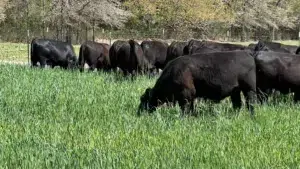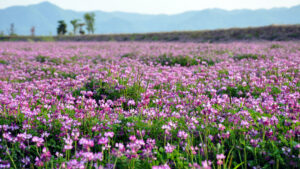It’s been a long wait for Hi-Gest Alfalfa Technology, but by spring 2019 Western Canadian producers will have it available to them for planting.
The variety that has the Hi-Gest alfalfa technology was developed by U.S.-based Dow AgroSciences brand Alforex Seeds and will be marketed in Canada by BrettYoung Seeds under the variety name Surge HG. The variety will be available exclusively through BrettYoung retailers for 2019 planting.
The variety might be a game-changer for the industry for several reasons, not least of which is the fact that it’s conventionally bred using traditional selection techniques, which ensures broad market access for organic and conventional hay producers alike.
But it’s the increased rate of fibre digestion and increased extent of fibre digestion that’s got alfalfa hay producers enthusiastic. Advance interest in the product means the company anticipates getting on considerable acres in Western Canada in the 2019 crop year and has supply ready to meet the demand, according to Erik Dyck, forage and turf product manager for BrettYoung.
Lignin is an organic polymer naturally found in the cell walls of many plants that gives them a rigid, woody structure. Typically, alfalfa is grown for use as a high-value feed for cattle. But lignin makes traditional alfalfa varieties difficult for cows to digest.

Added to this, the more an alfalfa plant matures, the more its lignin develops and decreases fibre digestibility, meaning alfalfa has to be harvested around the 28-day mark to ensure quality parameters are met.
Surge HG alfalfa has the flexibility to adjust to aggressive harvest systems to maximize yield and quality or to more relaxed schedules focused on tonnage, giving producers a tool to deal with weather and other factors affecting harvest timing. Either way, growers put the odds of improved returns per acre and animal performance in their favour.
According to Dyck, Surge HG sees development of more leafy material, which is of higher feed quality, and narrower stems.
“You end up seeing plants with higher leaf-to-stem ratio and higher canopy density,” he says. “With more leaves and less stem, as the crop matures, the fibre digestibility — when compared to other conventional varieties — will be improved.”
The new variety also maintains multiple pest resistance and yield performance, with lodging tolerance comparable to other commercial varieties.
There are significant—and measurable—payoffs for dairy producers using high quality alfalfa as feedstock. Dyck says Surge HG contains an increase in crude protein content anywhere from three to five per cent, which translates to 12 to 20 pounds of additional protein per tonne of alfalfa.
“If you factor all these things together, the net impact in terms of milk production can be 2.5 pounds per day per cow. Obviously for dairies it can have a very significant impact,” he says.
“In a nutshell, the benefit for the dairy industry is greater digestibility,” says Trevor DeVries, associate professor in the University of Guelph’s Campbell Centre for the Study of Animal Welfare and Canada Research Chair in Dairy Cattle Behaviour and Welfare.
“There are a variety of benefits that come with that, including greater efficiency of total dry matter use by the animal. And they may be able to harvest a little later, gaining extra yields of total dry matter from the field, without sacrificing feed quality as much as they would have with conventional types,” says DeVries.
While the benefits of Surge HG alfalfa are geared toward dairy producers, there’s also been interest from beef cattle producers and even export hay producers in Western Canada, says Dyck. “While the benefit to the beef industry is harder to measure, the improved forage quality and crude protein content will translate to more efficient feeding and in some instances may command a premium in export markets,” he says.

Market Access
Market access is top priority for those producers for whom Europe and China are destinations for alfalfa seed and hay.
It’s because of these markets’ zero-tolerance policies toward residual amounts of genetically modified alfalfa seed that containment of GM technology remains a key concern—and why GM low-lignin alfalfa has such a contentious history in Canada.
In the U.S., Monsanto’s genetically modified Roundup Ready HarvXtra alfalfa variety, which contains a low-lignin trait, has been available for three planting seasons.
HarvXtra alfalfa, sold by Forage Genetics International in Canada, has been approved by Canadian regulators for planting in Canada’s six eastern provinces for the sale of seed for hay production. But stakeholder concerns over containment issues and comprised market access have kept Forage Genetics International from launching HarvXtra seed in Western Canada.
Rene Van Acker, dean and professor at the Ontario Agricultural College at the University of Guelph, says that when genetically modified alfalfa was proposed for release in Western Canada, many farmers — two key groups in particular — were concerned: organic farmers, whose certification could be at risk at any sign of contamination, and forage seed exporters, who frequently export into Europe and China. Both groups must abide by zero tolerance policies for residual genetic material.
“In alfalfa, contamination is tricky,” says Van Acker. “It’s a very robust perennial that is insect-pollinated and having absolute containment is challenging with a species like that.”
But this doesn’t mean producers didn’t want the traits on offer. Brad Alexander, research and extension manager for the Alfalfa Seed Commission of Alberta (ASCA), says low-lignin alfalfa has been in demand by western Canadian producers for a long time.
The ASCA is doing its own trials to develop a low-lignin alfalfa via mutagenesis, a non-transgenic plant breeding method. “I know that farmers want this,” he says.
The majority of alfalfa seed grown in Alberta is exported, and China is a major market. Were these producers to lose market access to China, they’d be forced to compete with the U.S. for market share in countries more tolerant of residuals, says Alexander.
Dyck says the industry has heard objections to the sale and planting of genetically modified alfalfa varieties loud and clear.
“In light of the market context we have in Western Canada, an emphasis on conventional alfalfa plant breeding to deliver improved characteristics that have tangible benefits for growers is important and will continue,” he says.
But there’s excitement around the new product because while conventional plant breeding typically introduces incremental improvements year after year, Surge HG is an example of “a significant step towards improvement in quality”, says Dyck.
Alexander says producers’ concerns for low-lignin alfalfa varieties are the same as those they have for other varieties: standability and lodging resistance.
“They’re concerned every time the wind blows through southern Alberta and lodges the plants,” he says.
This summer, the commission conducted a trial with plant growth regulators (PGRs) to try to find a PGR that would help prevent lodging by shortening internode lengths to make plants more harvestable without affecting yield.
Further data is needed before trial results can turn into recommendations. But the trial is evidence that Alberta alfalfa producers are used to overturning challenges; new and improved varieties are more than worth the trouble it takes to find solutions.
A NOTE ON CRUDE PROTEIN
The increased rate of fibre digestion, extent of digestion, and crude protein data was developed from replicated research and on-farm testing. During the 2015 growing season at West Salem, WI and Woodland, CA, the following commercial dormant, semi-dormant and non-dormant alfalfa varieties were compared head-to-head with Hi-Gest alfalfa for rate of digestion, extent of digestion and percent crude protein; America’s Alfalfa Brand Ameristand 427TQ, Cropland Brands Legendairy XHD and Artesia Sunrise, Fertizona Brand Fertilac, S&W Seeds Brands SW6330, SW7410 and SW10, and WL Brands WL 319HQ and WL 354HQ. Also during the 2015 growing season, 32 on-farm Hi-Gest hay and silage samples were submitted to Rock River Laboratory for forage analysis. The results for rate of digestion, extent of digestion and percent crude protein were averaged and compared to the 60-day and four-year running averages for alfalfa in the Rock River database which included approximately 1,700 alfalfa hay and 3,800 silage 60 day test results and 23,000 hay and 62,000 silage tests results in the four year average.













